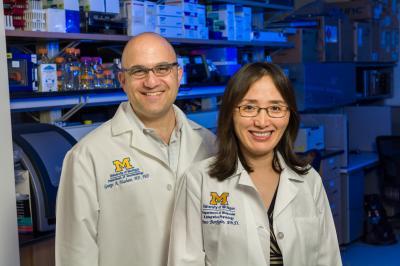Near-death experiences may have found a new grounding in science.
Whether and how the dying brain is capable of generating conscious activity has been vigorously debated but the near-death experiences reported by cardiac arrest survivors worldwide may be verifiable, according to a new paper.
Approximately 20 percent of cardiac arrest survivors report having had a near-death experience during clinical death. These visions and perceptions have been called "realer than real" but it remains unclear whether the brain is capable of such activity after cardiac arrest.
A new paper found that shortly after clinical death, in which the heart stops beating and blood stops flowing to the brain, rats display brain activity patterns characteristic of conscious perception.
"This study, performed in animals, is the first dealing with what happens to the neurophysiological state of the dying brain," says lead study author Jimo Borjigin, Ph.D., associate professor of molecular and integrative physiology and associate professor of neurology at the University of Michigan Medical School. "It will form the foundation for future human studies investigating mental experiences occurring in the dying brain, including seeing light during cardiac arrest.
"We reasoned that if near-death experience stems from brain activity, neural correlates of consciousness should be identifiable in humans or animals even after the cessation of cerebral blood flow."

The researchers analyzed the recordings of brain activity called electroencephalograms (EEGs) from nine anesthetized rats undergoing experimentally induced cardiac arrest. Within the first 30 seconds after cardiac arrest, all of the rats displayed a widespread, transient surge of highly synchronized brain activity that had features associated with a highly aroused brain.
Furthermore, the authors observed nearly identical patterns in the dying brains of rats undergoing asphyxiation.
"The prediction that we would find some signs of conscious activity in the brain during cardiac arrest was confirmed with the data," says Borjigin, who conceived the project in 2007 with study co-author neurologist Michael M. Wang, M.D., Ph.D., associate professor of neurology and associate professor of molecular and integrative physiology at the University of Michigan.
"But, we were surprised by the high levels of activity," adds study senior author anesthesiologist George Mashour, M.D., Ph.D., assistant professor of anesthesiology and neurosurgery. " In fact, at near-death, many known electrical signatures of consciousness exceeded levels found in the waking state, suggesting that the brain is capable of well-organized electrical activity during the early stage of clinical death."
The brain is assumed to be inactive during cardiac arrest. However the neurophysiological state of the brain immediately following cardiac arrest had not been systemically investigated until now.
"This study tells us that reduction of oxygen or both oxygen and glucose during cardiac arrest can stimulate brain activity that is characteristic of conscious processing," says Borjigin. "It also provides the first scientific framework for the near-death experiences reported by many cardiac arrest survivors."
Citation: Jimo Borjigin, UnCheol Lee, Tiecheng Liu, Dinesh Pal, Sean Huff, Daniel Klarr, Jennifer Sloboda, Jason Hernandez, Michael M. Wang, and George A. Mashour, 'Surge of neurophysiological coherence and connectivity in the dying brain ', PNAS August 12, 2013, doi:10.1073/pnas.1308285110





Comments